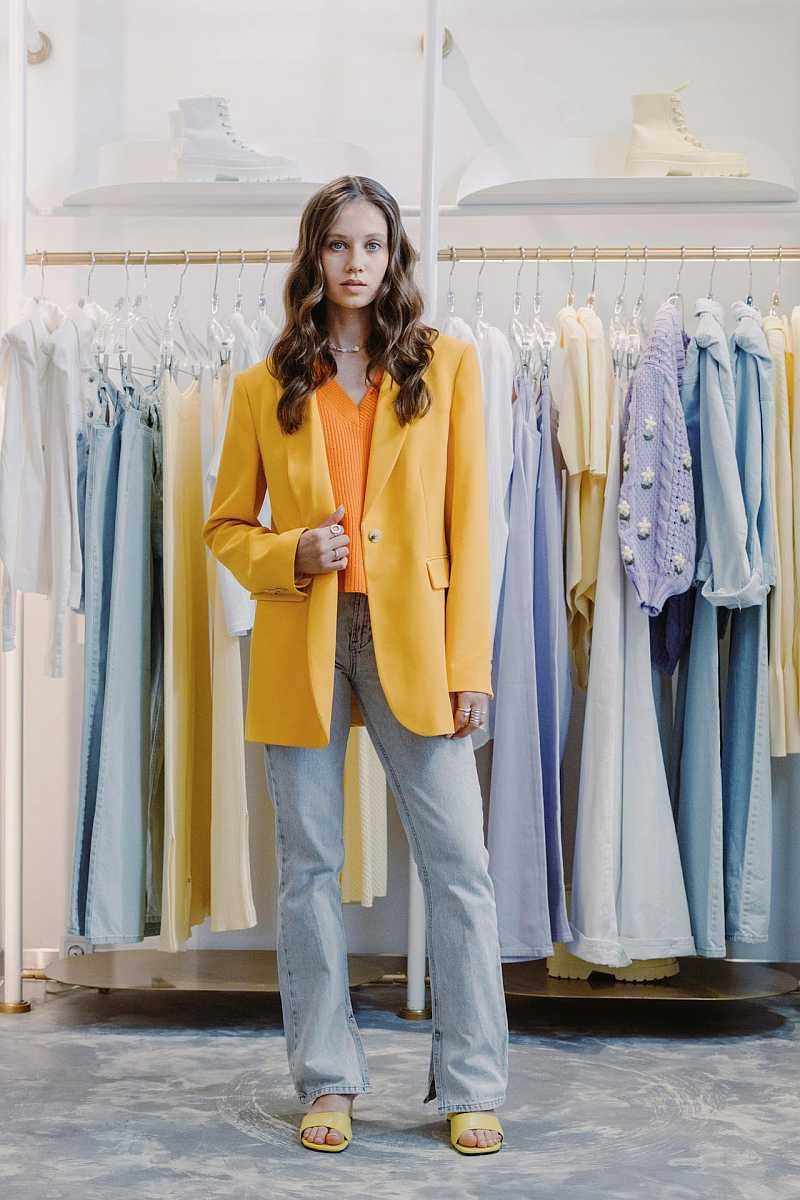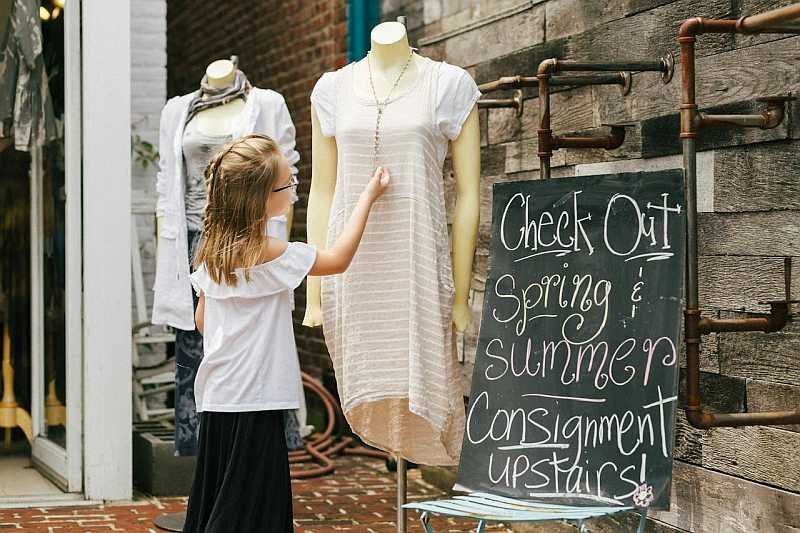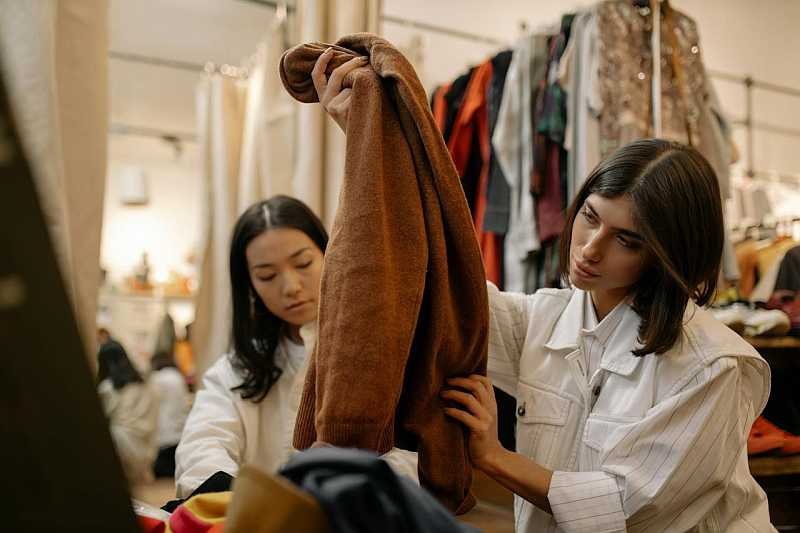In a world where fast fashion has dominated the industry for decades, the need for a more sustainable approach to style has never been more pressing. In this blog post, we delve into the realm of eco-friendly fashion, examining both the positive strides and concerning impact that the fashion industry has on the environment.
Eco-Friendly Fashion and Its Environmental Impact:
The Rise of Eco-Friendly Fashion
The fashion landscape has undergone a notable transformation with the emergence and widespread adoption of eco-friendly practices and brands. This seismic shift is propelled by a confluence of factors that reflect a changing consumer mindset and a heightened sense of responsibility toward the planet.
Consumer Consciousness
The primary catalyst for the surge in eco-friendly fashion lies in the awakened consciousness of consumers. Modern consumers are increasingly informed about the environmental impacts of their choices, prompting a shift in preferences toward more sustainable options.
This heightened awareness is fueled by readily accessible information through digital platforms, documentaries, and educational campaigns, empowering individuals to make informed decisions about the products they choose to support.
Demand for Transparency
A key driving force behind the rise of eco-friendly fashion is the growing demand for transparency within the industry. Consumers are no longer content with merely enjoying the end product; they seek visibility into the entire lifecycle of a garment.
Brands that embrace transparency by openly sharing information about their supply chains, sourcing practices, and production methods are gaining favor. This transparency not only builds trust but also allows consumers to align their values with the brands they choose to endorse.

Recognition of Environmental Issues
The fashion industry, once synonymous with glamour and creativity, has come under increased scrutiny due to its environmental impact. The rise of eco-friendly fashion is intrinsically tied to the growing acknowledgment of the detrimental effects of traditional fashion production on the environment.
Issues such as water pollution, excessive waste, and the depletion of natural resources have become focal points of concern. As a result, both consumers and industry insiders are recognizing the urgent need for change and are actively seeking alternatives that prioritize sustainability.
Innovations in Sustainable Technologies
Another contributing factor to the rise of eco-friendly fashion is the continuous innovation in sustainable technologies. Advancements in materials science, recycling processes, and eco-friendly manufacturing techniques have paved the way for a new era of fashion production.
Brands that invest in and adopt these technologies not only reduce their environmental footprint but also set a precedent for the industry, encouraging others to follow suit.
Government and Industry Initiatives
Governments and industry associations worldwide are increasingly recognizing the importance of sustainable practices within the fashion sector. Regulatory frameworks, incentives, and collaborative initiatives are being established to encourage responsible production and consumption.
This support from governing bodies is instrumental in creating a conducive environment for the growth of eco-friendly fashion.
In essence, the rise of eco-friendly fashion represents a paradigm shift in the industry’s values and practices. It signifies a collective acknowledgment of the need for change and a commitment to forging a more sustainable and ethical path forward.
As consumers, brands, and governing bodies continue to collaborate in this endeavor, the momentum behind eco-friendly fashion is likely to persist and shape the future of the entire fashion ecosystem.
Materials Matter
As we embark on the exploration of “Materials Matter” within the context of sustainable fashion, we unveil the intricate environmental narratives woven into various fabric choices. Let’s dissect this complex tapestry:
Water Consumption
Traditional Fabrics (e.g., Cotton): Illuminate the substantial water footprint inherent in conventional cotton cultivation. Emphasize the strain on water resources, particularly in regions grappling with water scarcity, and the ecological toll of this agricultural practice.
Sustainable Alternatives (e.g., Organic Cotton): Cast a spotlight on the virtues of organic cotton, grown without synthetic pesticides and fertilizers. Unveil the water-conserving qualities of organic farming, providing a sustainable counterpoint to conventional practices.

Energy Consumption
Traditional Fabrics (e.g., Polyester): Peer into the energy-intensive realm of synthetic fabric production, especially polyester. Explore the labyrinth of processes – from petroleum extraction to polymerization – that contribute to an exorbitant carbon footprint.
Sustainable Alternatives (e.g., Tencel/Lyocell): Introduce Tencel, a fabric born from sustainably sourced wood pulp, often extracted from eucalyptus trees. Navigate the eco-friendly currents of Tencel’s closed-loop production process, a beacon of sustainability amid energy-hungry alternatives.
Pesticide Use
Traditional Fabrics (e.g., Cotton): Confront the environmental and health quandaries surrounding the widespread use of pesticides in conventional cotton farming. Explore the far-reaching consequences on soil health, biodiversity, and the residual impact on the fabric itself.
Sustainable Alternatives (e.g., Organic Cotton): Champion the cause of organic cotton, liberating fashion from the shackles of synthetic pesticides. Illustrate how this alternative not only fosters healthier ecosystems but also ensures the well-being of those toiling in the fields.
Biodegradability
Traditional Fabrics (e.g., Polyester): Navigate through the challenges posed by non-biodegradable synthetic fabrics like polyester. Shed light on their persistent presence in landfills, painting a vivid picture of the long-term environmental repercussions.
Sustainable Alternatives (e.g., Tencel/Lyocell): Highlight the inherent biodegradability of Tencel, an eco-warrior breaking down barriers in contrast to its synthetic counterparts. Showcase the alignment of biodegradable fabrics with the principles of a circular fashion economy.
Renewable Resources
Traditional Fabrics (e.g., Cotton, Polyester): Acknowledge the strain on finite resources, such as fossil fuels, perpetuated by the production of synthetic fabrics like polyester.
Sustainable Alternatives (e.g., Tencel/Lyocell): Celebrate the renewable essence of wood pulp in Tencel production. Embark on a journey through responsibly sourced materials, championing a sustainable and regenerative ethos in the world of fashion.
Overall Environmental Impact
Traditional Fabrics (e.g., Cotton, Polyester): Conclude by weaving together the multifaceted environmental impact of traditional fabrics. Consider the intricate interplay of water and energy consumption, pesticide use, and the depletion of non-renewable resources.
Sustainable Alternatives (e.g., Organic Cotton, Tencel/Lyocell): Illuminate the overarching positive environmental narrative woven by sustainable alternatives. Emphasize their pivotal role in mitigating harm to ecosystems, conserving precious resources, and propelling the fashion industry toward a more eco-conscious horizon.
The Problem with Fast Fashion
The fast fashion model, characterized by its rapid production cycles and inexpensive, quickly-changing clothing designs, has profound negative consequences for both the environment and society.
Planned Obsolescence
Fast fashion often incorporates the concept of planned obsolescence, where garments are intentionally designed to have a short lifespan. This strategy encourages consumers to discard items quickly and buy new ones, perpetuating a cycle of constant consumption.
Manufacturers intentionally use low-quality materials and construction techniques, resulting in garments that wear out or go out of style swiftly.
Textile Waste Epidemic
The throwaway culture promoted by fast fashion contributes significantly to the global textile waste problem. As consumers discard clothing after only a few uses, landfills become inundated with textiles that do not readily decompose.
The synthetic materials commonly used in fast fashion, such as polyester and nylon, can take decades or even centuries to break down, exacerbating the environmental impact.

Resource Depletion
The rapid pace of production demands vast amounts of natural resources. From water-intensive cotton cultivation to energy-consuming manufacturing processes, fast fashion places immense pressure on the environment.
Additionally, the extraction of raw materials for clothing production, such as petroleum for synthetic fabrics, contributes to habitat destruction and resource depletion.
Toxic Chemical Usage
Fast fashion often involves the use of hazardous chemicals in dyeing, finishing, and treating textiles. These chemicals, including heavy metals and toxic dyes, pose serious risks to both environmental ecosystems and human health.
Runoff from manufacturing facilities can contaminate water sources, affecting aquatic life and local communities.
Exploitative Labor Practices
In the pursuit of cost reduction, fast fashion brands may engage in exploitative labor practices. This includes low wages, poor working conditions, and a lack of job security for garment workers.
The social implications of fast fashion extend beyond environmental concerns, highlighting issues of human rights and fair labor practices.
Cultural Impact
The fast fashion industry’s relentless pursuit of trends has cultural ramifications. Traditional craftsmanship and artistry often take a back seat to mass production, leading to the homogenization of global fashion.
This can result in the loss of cultural diversity in clothing styles and a diminishing appreciation for the artistry behind fashion creation.
Ephemeral Trends and Impulse Buying
The fast fashion model relies on creating ephemeral trends, encouraging consumers to make impulsive purchases based on the immediacy of fashion cycles.
This constant turnover contributes to a culture of overconsumption, where items are discarded long before their functional lifespan is exhausted.
In conclusion, the fast fashion industry’s negative environmental consequences are far-reaching, impacting ecosystems, natural resources, and human well-being. Addressing these issues requires a fundamental shift towards more sustainable and ethical practices, emphasizing longevity, quality, and responsible production methods.
As consumers become more informed and demand change, the industry is slowly evolving towards a more sustainable future.
Circular Fashion Economy: Rethinking Fashion for a Sustainable Future
The Circular Fashion Economy is rooted in core principles centered around waste reduction and sustainability across a garment’s entire lifecycle.
Departing from the linear “take, make, dispose” model, this approach focuses on closing the loop through design strategies that prioritize recyclability, reusability, and durability. Its overarching goal is to minimize the environmental impact of fashion production and consumption.
Designing for Recyclability
Within the circular fashion model, designers assume a crucial role in creating products with easily recyclable materials.
This entails selecting fabrics that can be broken down and repurposed into new garments, accessories, or other products, significantly reducing textile waste in landfills.
Embracing Reusability
Circular fashion encourages the creation of garments with extended lifespans, achieved through timeless designs or modular components that can be repaired or replaced.
This shift towards reusability promotes sustainable consumer habits and diminishes the demand for new products, thereby mitigating the environmental impact of constant production.

Showcasing Innovative Brands and Initiatives
Illustrating the effectiveness of circular fashion practices is vital. Pioneering brands that seamlessly integrate circular principles into their business models include:
- Rent the Runway: Disrupting traditional consumption patterns, this clothing rental service enables customers to rent high-quality, designer garments for special occasions, minimizing the need for one-time purchases.
- Patagonia’s Worn Wear Program: Embracing circularity, Patagonia encourages customers to trade in used gear for store credit, extending product life and diverting items from landfills.
- Eileen Fisher’s Renew Program: Through a closed-loop production system, Eileen Fisher takes back used garments, renews them, and resells them, reducing waste and fostering a sustainable, cyclical approach to fashion.
Benefits Beyond Waste Reduction
Exploring the broader advantages of circular fashion practices reveals:
- Resource Conservation: By reusing materials and extending product life, circular fashion minimizes the need for new resources, conserving energy, water, and raw materials.
- Economic Opportunities: Circular fashion creates new economic opportunities, from recycling facilities to the development of innovative technologies supporting sustainable practices.
- Consumer Engagement: Circular fashion positively impacts consumer engagement as individuals become more aware of their role in creating a circular economy, making conscious choices in favor of sustainable fashion.
The Circular Fashion Economy represents a transformative approach to the fashion industry, fostering a sustainable and regenerative system benefiting both the planet and the industry itself.
By spotlighting successful examples and emphasizing multifaceted advantages, we encourage a shift towards a more responsible and circular future for fashion.
Fashion’s Impact on Biodiversity
Deforestation and Fiber Production
The allure of conventional cotton and wood-based fabrics often leads to vast swaths of deforested lands. As cotton plantations and timber production encroach upon natural habitats, biodiversity suffers.
Introducing sustainable alternatives like organic cotton becomes pivotal, offering a path to responsible farming practices that coexist harmoniously with diverse ecosystems.
Water Pollution and Aquatic Ecosystems
The mesmerizing hues of our clothing often come at a hidden cost—water pollution. Toxic chemicals from dyeing and finishing processes contaminate water sources, imperiling aquatic ecosystems.
The adoption of eco-friendly dyeing methods and advanced water treatment technologies emerges as a beacon, steering us away from this perilous path.
Chemical Use in Agriculture
In the pursuit of abundant fiber production, conventional agriculture relies heavily on pesticides and fertilizers. Unveiling the impact of these chemicals on biodiversity, we advocate for organic farming practices.
By minimizing chemical inputs, we can nurture the soil, preserve biodiversity, and cultivate sustainable agricultural landscapes.

Loss of Biodiversity in Natural Fibers
Monoculture practices in traditional cotton farming strip the agricultural landscape of biodiversity. The dominance of a single crop stifles variety, disrupting the delicate balance of plant and insect species.
Introducing agroecological approaches breathes life into our fields, fostering biodiversity within the very fabric of our natural fibers.
Wildlife and Habitat Destruction
Beyond fabrics, the extraction of materials like leather and metals exacts a toll on wildlife and habitats. Mining operations lead to habitat destruction and the displacement of wildlife.
Advocating for sustainable sourcing practices becomes synonymous with advocating for wildlife conservation, urging us to prioritize the protection of natural habitats.
Sustainable Fashion and Biodiversity Conservation
As we navigate the complex ecosystem of fashion, we encounter beacons of change. Brands and initiatives committed to eco-friendly materials, sustainable production, and biodiversity conservation efforts emerge as champions of a harmonious coexistence.
Embracing their ethos invites consumers to play a role in preserving biodiversity through mindful choices.
In this exploration, we’ve traversed the realms where fashion and biodiversity intersect. The choices we make in our closets reverberate in ecosystems far and wide. As we stand at this crossroads, let us embrace the transformative power of sustainable fashion, weaving a narrative that honors both style and the rich tapestry of life on our planet.
Consumer Awareness and Ethical Choices
Choose Wisely: Embracing Ethical and Sustainable Brands
Consumer choices wield immense influence in transforming the fashion industry. Opting for ethical and sustainable brands is a powerful way to foster positive change.
Look for brands committed to fair labor practices, eco-friendly materials, and transparent supply chains.
Supporting Ethical Initiatives: A Vital Consumer Role
By supporting initiatives that prioritize ethics, consumers become key advocates for ethical standards in the industry.
Be a part of the change by endorsing brands that align with your values.
Mindful Consumption: From Quantity to Quality
Shift your perspective from quantity to quality. Reflect on your buying habits, considering the environmental and social implications of each purchase.
Choosing high-quality, timeless pieces challenges the disposable nature of fast fashion and promotes sustainability.

Embrace Slow Fashion: Deliberate and Thoughtful Choices
Adopt the principles of slow fashion by choosing fewer, but higher-quality items. This deliberate approach contributes to reducing the demand for mass-produced fashion, aligning your choices with sustainable practices.
Understanding True Costs: Ethical Considerations Matter
Recognize the hidden expenses associated with cheap, fast fashion. Consider ethical factors such as exploitative labor practices and environmental degradation, even if it means a higher upfront investment.
Understand the true cost of fashion to make informed choices.
Promote a Circular Wardrobe: Extend Garment Lifespan
Promote a circular wardrobe by extending the lifespan of your garments through proper care, repairs, and creative styling.
Embrace the principles of a circular economy, reducing the overall environmental impact of fashion consumption.
Engage in Sustainable Practices: Clothing Swaps and Secondhand Shopping
Reduce the demand for new clothing production by engaging in sustainable practices such as clothing swaps and secondhand shopping.
Contribute to a more sustainable and circular fashion economy by giving pre-loved items a second life.
Advocacy through Social Media: Empowerment for Change
Utilize social media platforms for advocacy. Raise awareness and hold brands accountable by sharing information about sustainable fashion practices on platforms like Instagram and Twitter.
Join a community committed to positive change through collective action.
Empower yourself as a conscious consumer by making informed and ethical choices. Your decisions contribute to reshaping the fashion landscape towards sustainability.
Together, let’s foster a community that values ethical standards, environmental responsibility, and positive change in the fashion industry.
The Carbon Footprint of Fashion
Making Clothes – How Does It Affect the Planet?
- Traditional Methods: Think about the energy and chemicals used in making clothes. It’s a lot!
- Sustainable Solutions: Discover new ways designers are creating clothes using less water, fewer chemicals, and even harnessing the power of the sun and wind.
Clothes on the Move – Where do They Travel?
- From Here to There: Ever thought about how your clothes get to the store? It involves planes, ships, and trucks, which contribute to pollution.
- Closer is Greener: Learn why supporting local designers and brands is not just stylish but also eco-friendly. It’s a win-win!

Saying Goodbye to Clothes – What Happens Next?
- Dumping Dilemma: Most old clothes end up in landfills, taking ages to break down and releasing harmful gases.
- Recycling Revolution: Explore the idea of recycling clothes and how some brands are turning old stuff into new treasures. Plus, find out how you can join the recycling squad!
Powering Up with Green Energy
- Clean Energy Chic: Learn about fashion brands that are choosing renewable energy sources like solar and wind to power their factories.
- Energy Efficiency Hacks: Discover cool technologies that make fashion production more energy-efficient and less harmful to the environment.
Smarter Shipping for Stylish Stuff
- Eco-Friendly Deliveries: Ever thought about how your online shopping gets to your doorstep? There are greener ways!
- Smart Shipping Tips: Check out how brands are changing their shipping game to reduce their carbon footprint, and how you can support these efforts.
Your Clothes, Your Planet – Recycle and Reuse
- Be a Recycling Pro: Understand why recycling your old clothes is a big deal for the planet.
- Brands Doing Good: Discover fashion brands that encourage you to send back your old clothes for recycling and reward you for being an eco-warrior.
Offsetting Carbon with Fashion
- The Offset Idea: Find out how some fashion brands are giving back by investing in projects that help balance out their environmental impact.
- See Through Transparency: Learn why it’s crucial for brands to be open about their efforts to offset carbon and contribute positively to the environment.
Your Power as a Fashionista
- Fashion with a Purpose: You have the power to make sustainable fashion choices. Learn how to support eco-friendly brands and make your wardrobe a force for good.
- Small Changes, Big Impact: Discover simple lifestyle changes that can make your fashion journey more mindful and planet-friendly.
Shaping Fashion Policy for a Greener Future
- Rules for a Greener Runway: Understand how policies and regulations can push the fashion industry to be more environmentally conscious.
- Team Effort: Explore collaborations between fashion influencers, governments, and eco-organizations to make the fashion world a greener place.
Keeping Score: Are We Making Progress?
- Measuring Change: Find out why it’s essential for fashion companies to show their eco-credentials and how they’re improving.
- Join the Green Movement: Discover how you, as a fashion lover, can encourage the fashion industry to keep moving towards a more sustainable future.
In conclusion, being a fashionista doesn’t mean ignoring the planet. Let’s embrace sustainable fashion choices, support brands making a positive impact, and together, we can turn the fashion industry into a force for good!
Fashion Activism
In a world where self-expression meets social responsibility, the intersection of fashion and activism has become a powerful catalyst for change.
This exploration delves into the dynamic realm of Fashion Activism, where designers, influencers, and consumers unite to advocate for sustainability and social responsibility within the fashion industry.
The Power of Style as a Catalyst for Change
Fashion has evolved beyond being a mere trendsetter; it has emerged as a tool for activism. Designers now recognize the influence they hold and leverage their creativity to make a positive impact on the world.

Designers Pioneering Sustainable Fashion
Explore the innovative approaches of designers who are leading the charge for sustainability in the fashion industry.
From utilizing eco-friendly materials to adopting ethical production practices, these trailblazers are reshaping the narrative of fashion, proving that style and sustainability can coexist harmoniously.
Influencers as Advocates for Change
Fashion influencers, with their substantial online presence, have become key players in promoting conscious consumerism. Showcase examples of influencers using their platforms to educate and inspire their followers to make mindful fashion choices.
These individuals play a crucial role in amplifying the message of sustainability and social responsibility.
The Rise of Conscious Consumerism
Explore how consumers are increasingly demanding transparency and ethical practices from fashion brands. As awareness grows, consumers are making informed choices, favoring brands that align with their values.
Movements Driving Ethical Practices
Dive into the various movements and campaigns that champion ethical practices and transparency in the fashion industry. From calls for fair labor practices to demands for cruelty-free fashion, these movements are reshaping the industry’s norms and encouraging a more responsible approach.
Fashion Activism is not merely a trend; it’s a paradigm shift that embraces style as a force for positive change. As we witness designers, influencers, and consumers unite in advocating for sustainability and social responsibility, it becomes evident that fashion has the potential to drive a more conscious and compassionate industry.
Join the movement, and let your style be a statement for a better, more sustainable future.
Tech-Driven Innovations in Sustainable Fashion
From reducing waste through 3D printing to elevating the online shopping experience with virtual fitting rooms and enhancing supply chain transparency with blockchain technology, the marriage of fashion and tech is fostering a new era of eco-conscious innovation.
Precision and Waste Reduction with 3D Printing
The fashion industry has long grappled with the environmental impact of mass production and textile waste. Enter 3D printing, a revolutionary technology that has the potential to redefine how garments are created.
By utilizing precision engineering, 3D printing allows designers to manufacture clothing with unparalleled accuracy, minimizing material wastage. This eco-friendly approach not only reduces the carbon footprint of the fashion industry but also opens the door to customizable, made-to-order clothing, promoting a more sustainable and consumer-centric model.
Elevating Online Shopping with Virtual Fitting Rooms
As the digital realm continues to shape our retail experiences, virtual fitting rooms have emerged as a game-changer for online shoppers. This innovative technology leverages augmented reality to provide customers with a virtual try-on experience, allowing them to visualize how a garment fits and looks before making a purchase.
Not only does this enhance customer satisfaction, but it also reduces the likelihood of returns, contributing to a significant reduction in the environmental impact associated with reverse logistics and excess inventory.

Blockchain Technology for Transparent Supply Chains
In the pursuit of sustainable fashion, transparency in the supply chain is paramount. Blockchain technology, known for its decentralized and secure ledger system, is making waves by offering a solution to the longstanding issue of traceability.
By implementing blockchain, fashion brands can trace the origins of materials, ensuring ethical sourcing and responsible manufacturing practices. This heightened transparency not only builds trust among consumers but also holds industry players accountable for their environmental and social impact, fostering a culture of responsibility and sustainability.
As technology continues to evolve, its integration into the fashion industry brings forth a wave of sustainable practices that hold the promise of a greener future.
From 3D printing’s precision-driven waste reduction to virtual fitting rooms transforming online shopping experiences and blockchain ensuring transparency in the supply chain, these tech-driven innovations are reshaping the narrative of fashion.
By embracing these advancements, the industry not only meets the growing demand for eco-conscious practices but also paves the way for a more sustainable and responsible future in fashion.
Educational Initiatives and Awareness Campaigns
In the ever-evolving landscape of the fashion industry, the imperative to adopt sustainable practices has become more crucial than ever.
Recognizing the transformative power of education, various initiatives and awareness campaigns have emerged to enlighten industry professionals and consumers alike about the profound environmental implications of their fashion choices.
In this exploration, we shed light on the significance of education in nurturing a sustainable fashion ecosystem, unveiling notable organizations and programs spearheading the charge for positive change.
Importance of Education in Sustainability
Education serves as the cornerstone for cultivating a conscious and sustainable fashion industry. By imparting knowledge about the environmental impact of fashion, stakeholders gain a deeper understanding of the consequences of their choices.
From design to production and consumption, education empowers individuals to make informed decisions that contribute to the overall well-being of the planet.
Initiatives Targeting Industry Professionals
Several organizations are dedicated to educating and inspiring professionals within the fashion industry. Institutes and workshops, such as the Sustainable Apparel Coalition and the Fashion Revolution, focus on equipping designers, manufacturers, and retailers with the knowledge and tools necessary to integrate sustainable practices into their processes. These initiatives foster a community of like-minded professionals committed to reshaping the industry from within.
Campaigns Geared Towards Consumers
Educating consumers is equally paramount in steering the fashion industry towards sustainability. Initiatives like the #WearTheChange campaign by C&A and the H&M Conscious Collection leverage marketing strategies to raise awareness among consumers.
By emphasizing the environmental impact of their choices and promoting eco-friendly alternatives, these campaigns empower individuals to make responsible purchasing decisions.
Organizations Pioneering Change
Several organizations have emerged as champions of sustainable fashion education and awareness. The Ellen MacArthur Foundation, through its Circular Fashion Program, promotes a circular economy by educating industry stakeholders on sustainable design and consumption.
Similarly, the Sustainable Fashion Academy advocates for sustainable practices through training programs, emphasizing the need for systemic change in the fashion ecosystem.

Programs Driving Positive Change
Educational programs play a pivotal role in instigating positive change. The Common Objective’s Sustainable Fashion Business Toolkit, for instance, provides comprehensive resources for businesses seeking to adopt sustainable practices.
Additionally, initiatives like the Slow Fashion Season challenge consumers to abstain from fast fashion for three months, encouraging a shift towards more mindful and sustainable consumption habits.
As the fashion industry undergoes a paradigm shift towards sustainability, educational initiatives and awareness campaigns stand at the forefront of this transformative journey.
By fostering a shared understanding of the environmental impact of fashion choices, these efforts pave the way for a more conscientious industry that prioritizes the well-being of our planet.
As consumers and professionals alike embrace the principles of sustainability, a brighter, more eco-conscious future for the fashion industry comes into focus.
Conclusion
As we navigate the intricate web of fashion and its impact on the environment, it becomes evident that embracing eco-friendly practices is not merely a trend but a necessity for the well-being of our planet.
By understanding the consequences of our fashion choices, supporting sustainable brands, and fostering a culture of conscious consumption, we can collectively work towards a more sustainable and harmonious relationship between fashion and the environment.




